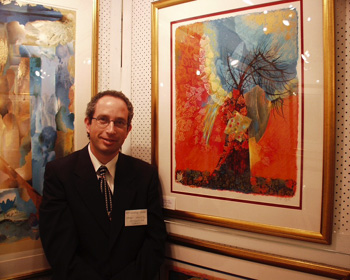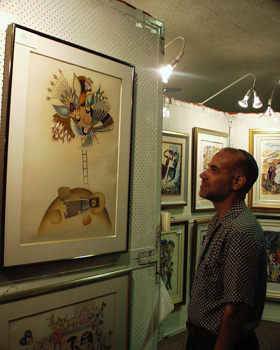| By
Donald H. Harrison
San Diego, CA (special) -- It was an ironic way to describe the circumstances
surrounding an Israeli art show, especially one featuring so much Judaica,
but the saying illustrated the point which Menachem Safrai wanted to make
in an interview with HERITAGE:
"If Muhammad won't go to the mountain, then the mountain must go to
Muhammad."
 |
Safrai, a fourth generation art dealer whose Safrai Fine
Art Gallery is
located near the King David Hotel in Jerusalem, said that in the wake
of
the Second Intifada tourism to that international city has dropped
tremendously.
"We have only 10 percent of what we used to have," he said. "It has
been
quite harmful to our business and every business involved with tourism.
Hotels, restaurants -- everyone is suffering."
Luckily for Safrai, he handles |
FOURTH-GENERATION ART DEALER--Menachem
Safrai of
the Safrai Fine Art Gallery in Jerusalem particularly
admires
"Phoenix Bird No.1" by Shraga Well. It utilizes the
legend of
the Phoenix, which rose from the ashes to symbolize
modern
israel. |
productswhich are portable. In fact, he packed more than 2,000 pieces of
art in 130 crates and shipped them to the United States. The art show from
May 3 through May 6 at San Diego's
Tifereth Israel Synagogue was the third of four exhibitions in this
country. Previously the works were examined by art lovers in Redwood
City, Cal. and Las Vegas, Nev., and they will travel next to Baltimore,
Md.
Having mounted such traveling exhibitions since the time of the Six
Day
War in 1967, the Safrai Gallery has the process well-systematized.
The
synagogues which host the art shows receive a percentage of the sales,
and they and the gallery share in the promotion costs.
Safrai has been with the family business since 1985, when he completed
his Israeli Army service. His grandfather started the gallery in 1935,
but
even before that his great-grandfather was buying and selling art in
Jerusalem, to which he immigrated from the United States around 1917.
 |
In the United States, the family name was Bookbinder, but
Safrai's father changed it in response to the appeal by Israel's first
Prime Minister that his countrymen Hebraicize their names.
As Safrai's immigrant family influenced the art scene in Israel, so
too have the various waves of immigrants who have come to Israel since,
Safrai said. Now, for example, Israeli art is greatly influenced by the
large aliyah from the former Soviet Union.
|
DANCING CHASIDIM--These happy Chasidim
appear in a
watercolo by Alexander Klevan, a recent immigrant
to Israel
from the former Soviet Union. |
"When artists come from Russia, they start with the color range that they
work with in Russia which is from gray to black," Safrai said only
half-
jokingly. "Then they come to Israel, and they change 180 degrees (to
bright colors), and then after a year or two it stablizes in the middle."
The art dealer said he tried to pick for exhibition works that reflected
"different themes, different artists, different styles, different
techniques because Israel is a nation of immigrants."
One hundred ten artists were represented in the Tifereth Israel Synagogue
show, with their works selling at prices between $80 and $18,000.
Safrai guided me on a quick tour through the exhibit, stopping here
and
there to share some tidbits about the artists or their works.
One of the Russian immigrants represented in the exhibition was
Alexander Klevan, whose water colors typically reflect both a sense
of
motion and humor.
"The blending of the colors, especially for watercolors, is very
diffiicult," Safrai said. "With watercolors you can't make a mistake.
In an
oil you can just cover it up. Watercolors have to be perfect the first
time
you do it and he is a superb artist."
A few paces and we stopped again: "One of the masters we have here is
Abraham Binder," Safrai said. "He is 94 years old and is one of the
founders of Israeli art. He is still alive, still painting, and these
are
watercolors and lithographs. We didn't bring any oils because the price
range for his oils is quite expensive, and for the show it is not worth
it to
shlep. "
We stopped in front of a few other artists, then strolled on to the
works
of Shraga Weil. "Here we have another artist we have worked with for
over 40 years," Safrai said. "All his works have stories and ideas
behind
them. One of the interesting stories is that of the Phoenix bird which
rises out of its own ashes. Here we have Israel after 2,000 years of
the
Diaspora..." He pointed out Weil's depiction of Israel as the legendary
bird
included "the breast plate of the high priest with the stones symbolizing
Israel, the many colors of the coat of Joseph; the cut-down tree with
leaves growing out of it."
 |
I asked Safrai to pose for a photograph by whichever work at the exhibit
he liked best. He chose to stand by Weil's Phoenix Bird No. 1, which
is one
in a series of three. Weil's pieces, he said, "are Judaic works, but
we
don't see a rabbi with a book."
Later, I asked Rabbi Leonard Rosenthal of Tifereth Israel Synagogue
to
show me his favorite work. He promptly led me to a painting by David
Sharir, illustrating the well-known Biblical story of Jacob's dream.
I found myself enjoying a piece by Klevan which showed three Chassidim
in a joyous dance. It made me smile to see them so happy in a
Conservative synagogue. |
JACOB'S DREAM-- Rabbi Leonard Rosenthal
of
Tifereth Israel Synagogue felt drawn to this
depiction by Israeli artist David Sharir of the
biblical Jacob's famous dream at Beth El. |
|

